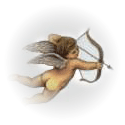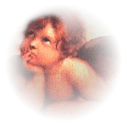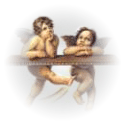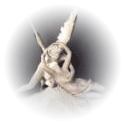Symbol - a communication element intended to simply represent or stand for a complex of person, object, group, or idea. Symbols may be presented graphically for example Cupid. He is portrayed as a winged cherub armed with a bow and arrow. He shoots gods and people to instill love and passion and offen appears with his mother or his brothers.
 Eros (Roman Amor called also Cupid) god of earthly love and pleasure, son of beautiful
goddes of love and beauty Aphrodite (Roman Venus) and god of war Aries (Roman Mars). He inherited all
the best characteristic of his parents:
charm, seduction, sexual desire which was provoked by charm and seduction, conquering, jealousy, blindness, aggressivness
and pugnacity.
Eros (Roman Amor called also Cupid) god of earthly love and pleasure, son of beautiful
goddes of love and beauty Aphrodite (Roman Venus) and god of war Aries (Roman Mars). He inherited all
the best characteristic of his parents:
charm, seduction, sexual desire which was provoked by charm and seduction, conquering, jealousy, blindness, aggressivness
and pugnacity.
In general he was depicted as a small, chubby, impish and pritty winged boy, with bow and arrow in his hand and quiver on his back, shooting not only mortals but also gods in the heart and thus enticing them to fall deeply in love. He did not respect laws, customs, hierarchy, age, and social status of his victims and sometimes he was punished for the mischief that his arrows caused by those, who disapprove his activities. In ancient Greek times the guardian of chastity virgin goddesses Diana and warrior goddes Minerva fought him to avoid his poisoned arrows, passion of love and to protect their individualaity. They stole, broke or burnt his arrows while he was sleeping, or cliped his wings. In Renaissance time and later his brother Anteros fought him to protect the soul against diverting the minf of divine contemplation.
 His arrows inspired love or passion, but his actions did not always seem to be beneficial.
People in love often loose their reason. The earthly love paralize their willpower,
loose their temper, make them jealous, or inspire animal sexual desire.
He hatched intrigues and then resolved them. He also enjoyed the marry company of Dionysus (Roman Bachus),
the god responsible for orgies, conofusion and wars.
His arrows inspired love or passion, but his actions did not always seem to be beneficial.
People in love often loose their reason. The earthly love paralize their willpower,
loose their temper, make them jealous, or inspire animal sexual desire.
He hatched intrigues and then resolved them. He also enjoyed the marry company of Dionysus (Roman Bachus),
the god responsible for orgies, conofusion and wars.
Although some saw as callous and careless, he was generally viewed as beneficient on account of the happienes he imparted to couples both mortal and immortal. Every once in a while, however, he make his misdeed and shoot a golden arrow responsible for happy, reciprocaled love instead of lead one, which makes someone feel aversion toward whoever loves him or her.
 Aphrodite/Venus concerned that her young son seemed to have stop growing and not very happy from his
many misdeeds, was told by him that only a brother would cure the trouble. He was thererfore given
Anteros as a brother, who symbolized reciprocaled love. They are usually portrayed as twings, fighting together
or reconciled and embracing.
Aphrodite/Venus concerned that her young son seemed to have stop growing and not very happy from his
many misdeeds, was told by him that only a brother would cure the trouble. He was thererfore given
Anteros as a brother, who symbolized reciprocaled love. They are usually portrayed as twings, fighting together
or reconciled and embracing.
 The Cupid's little brother Anteros was not powerfull enough to cure the wounds made by Cupid's misdeeds.
Cupid was therefore given a second brother Liseros, who symbolizes the power that makes love subside.
The Cupid's little brother Anteros was not powerfull enough to cure the wounds made by Cupid's misdeeds.
Cupid was therefore given a second brother Liseros, who symbolizes the power that makes love subside.
In Renaissance and later eras his presence on the picture indicates that the narrative subject of the story is
amorous. Most
often he is depicted playing with his weapon, shooting gold or lead arrows, or making his bow
as can be seen on the Parmigianino's painting "Cupid makes a bow".
Parmegianino portraited him as beautiful, young stripling glancing provocatively at a viewer and simultaneously
concentrating on making his bow. The cherub happily looking toward
the observer is his little brother Anteros, the god of mental reciprocal or requited love. The cherub
who seems pulling back from touching hin for fear of fire
is his little brother Liseros, the personification of the force that makes love subside.
To distinguish the profane, sensual, earthly love as oposed to the divine, sacred love aimed on contemplation
Cupid is shown blindfolded. He is shown blindfolded not only to emphasize fact that profane love is blind,
but to symboliaze the darknes of sin. Blindfolded Cupid began appearing in art in Middle Ages.
 The legend tells the story of Amor and the mortal maiden, Psyche. Psyche was so beautiful that her
beuty frightend the young people and could not find a husband. Venus was terribly jealous of the beauty of
Psyche, and ordered Amor to instill passion in her for a depraved man. But instead his arrow hit his
heart so deeply that Amor felt deeply in love with her. He took her as his wife, but as a mortal
she was forbidden to look at him. He built for her a splendid palece where he comes to visit her
each night. Psyche was happy until her two jeleaus sisters convinced her to look at him.
When the temptation to see him become to great for her, when he come home she light had hidden lamp.
She cought sight of him, handsome young man, but it was the and of her happieness. Amor
punished her disobeydience by departing. Their lovely castle and gardens vanished with him.
The legend tells the story of Amor and the mortal maiden, Psyche. Psyche was so beautiful that her
beuty frightend the young people and could not find a husband. Venus was terribly jealous of the beauty of
Psyche, and ordered Amor to instill passion in her for a depraved man. But instead his arrow hit his
heart so deeply that Amor felt deeply in love with her. He took her as his wife, but as a mortal
she was forbidden to look at him. He built for her a splendid palece where he comes to visit her
each night. Psyche was happy until her two jeleaus sisters convinced her to look at him.
When the temptation to see him become to great for her, when he come home she light had hidden lamp.
She cought sight of him, handsome young man, but it was the and of her happieness. Amor
punished her disobeydience by departing. Their lovely castle and gardens vanished with him.
This story of Amor and Psyche fascinated all epoks artists, who portrayed the various episods of the story.
The sculpture of "Amor and Psyche" commissioned by Colonel John Campbell in 1787, represents the most dynamic moment of the story. In his a harmonious and perfectly balanced composition Canova preserved the acme moment, when Cupid bends down to restore Psyche to her senses with a kiss after her disobedience to Venus prohibition. The tender embrance of the young couple is only hinted at and their hands just gentle skim over each other's body as if in a dance. No sign of passion, grace and harmony, happy union of reason and sentiment, pure love. Canova's fame spead quickly across Europe and in 1794 Prince Yusupov commissioned a similar statue, which can be seen in Hermitage, St. Petersburg, Russia. .